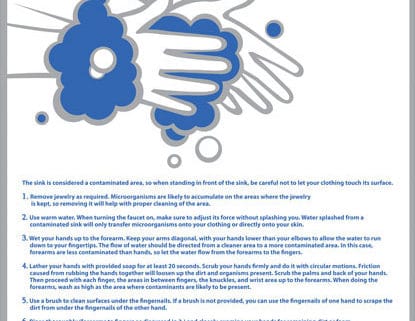Medical Hand Washing Informational
Full Color Motivational Safety Poster 18″ x 24″ Laminated
Medical Hand Washing
The sink is considered a contaminated area, so when standing in front of the sink, be careful not to let your clothing touch its surface.
1. Remove jewelry as required. Microorganisms are likely to accumulate on the areas where the jewelry is kept, so removing it will help with proper cleaning of the area.
2. Use warm water. When turning the faucet on, make sure to adjust its force without splashing you. Water splashed from a contaminated sink will only transfer microorganisms onto your clothing or directly onto
your skin.
3. Wet your hands up to the forearm. Keep your arms diagonal, with your hands lower than your elbows to allow the water to run down to your fingertips. The flow of water should be directed from a cleaner area to a more contaminated area. In this case, forearms are less contaminated than hands, so let the water flow from the forearms to the fingers.
4. Lather your hands with provided soap for at least 20 seconds. Scrub your hands firmly and do it with circular motions. Friction caused from rubbing the hands together will loosen up the dirt and organisms present. Scrub the palms and back of your hands. Then proceed with each finger, the areas in between fingers, the knuckles, and wrist area up to the forearms. When doing the forearms, wash as high as the area where contaminants are likely to be present.
5. Use a brush to clean surfaces under the fingernails. If a brush is not provided, you can use the fingernails of one hand to scrape the dirt from under the fingernails of the other hand.
6. Rinse thoroughly (forearms to fingers as discussed in 3.) and closely examine your hands for remaining dirt or foam.
7. Dry hands and use towel to turn off the faucet.



